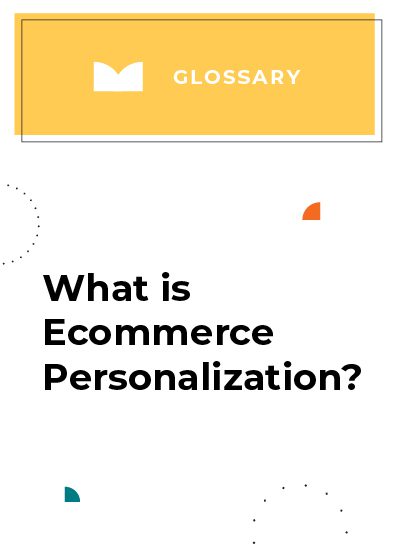
Ecommerce Personalization
Personalized eCommerce experiences increase product purchases, boost revenue, and fuel brand loyalty. In Twilio’s 2021 State of Personalization ReportOpens a new window, 60% of the 3000 consumers surveyed said they would become repeat buyers after a personalized shopping experience. This was up from 44% in 2017.
Perhaps even more telling—almost half of respondents said they’re less likely to make a repeat purchase after an experience lacking in eCommerce personalization. Powerful personalization technology can enable retailers to meet high consumer expectations.
What Is Ecommerce Personalization?
Ecommerce Personalization is the process of creating personal interactions and experiences on ecommerce sites by dynamically showing individualized experiencesOpens a new window — content, media, or product recommendationsOpens a new window — to customers.
The recommendations are generated using shoppers’ browsing behavior, purchase history data, demographics, and psychographics.
Research has shown that consumers—especially younger generations—are willing to share personal data like style preferences and household needs in exchange for better, more personalized shopping experiences.
Why Use Ecommerce Personalization?
Personalization in eCommerce is a necessity, particularly in a world where online shopping is closer to being the rule rather than the exception.
In addition to purchasing more stuff online, another behavior that promises to become a norm is consumers’ willingness to shift to new brands. This shift is usually a result of economic pressures, store closings, and changing priorities.
McKinsey found that 80% of customers began using a private brand during the pandemic plan to stick with that brand afterward. This puts even more pressure on retailers to get it right when it comes to delivering a highly personalized customer shopping experience across channels.

What Are the Benefits of Ecommerce Personalization?
Consumers want to be known. Nearly 70% of respondents in the Twilio survey wanted brands to know more about them, even though it meant giving up more personal data.
Ecommerce personalization delivers better experiences at scale by leveraging browsing behavior, purchase history data, demographics, and psychographics to provide customized product and content recommendations across all customer channels.
Beyond a better customer experience, there are other significant benefits to eCommerce personalization. These include:
Higher Average Order Value (AOV)
Our research has found that return visits for recommended products yield up to 40% higher AOVOpens a new window than return visits for non-recommended products. Loyal customers also tend to spend more, with the average AOV for returning customers roughly 5% higher than first-time buyers.
Higher Conversion Rates
One study found that visitors who viewed three pages of personalized content converted at a rate of 3.4% versus 1.7% for people who viewed two personalized pages.
Increased Customer Loyalty
Getting personalization right increases conversion rateOpens a new window and customer loyalty, with 70% of customers surveyed saying that a brand’s understanding of their personal needs impacts their loyalty to that brand.
Cross-Channel Personalization Experiences
Omnichannel personalizationOpens a new window enables retailers to link online and offline touchpoints, for example, by connecting online browsing behavior to in-store behavior, allowing a POS feedback loop that ensures online product recommendations are individualized to reflect in-store purchases (and vice versa).
What’s the Impact of Personalizing Your CX?
What’s personalization’s potential impact to your business? Find out now.

How To Deploy Ecommerce Product Personalization Experiences
We recommend building an eCommerce personalization strategy using Forrester’s POST methodology. POST stands for People, Objectives, Strategy, and Technology.
The Forrester approach is focused on helping retailers launch a successful website personalizationOpens a new window program from conceptualization through to implementation. It can be summarized in four steps, as follows:
Step 1: People (Choose Your Customers)
The first step in creating a personalization strategy should be focused on figuring out which customers you’re trying to serve. To do this, you must analyze your segmentation and targeting data to identify your most valuable customers and their preferences. You can then create dynamic profiles based on demographics, browsing preferences, social media activity, and other signals. Once profiles are created, you can match customer shopping experiences to individual expectations across multiple touchpoints and channels.
Step 2: Objectives (Determine Your Personalization Goal Metrics)
Defining objectives for your personalization initiative enables you to measure success. It’s an important part of the POST methodology that helps shape your business’s unique personalization strategy. Retailers frequently use personalization to optimize for KPIsOpens a new window like Revenue, Conversion Rate, Bounce Rate, or Engagement; but you might also choose to develop your own metrics or choose from a variety of other options, including:
- Average Page Views
- Add-to-Cart Rate
- Cart Abandonment Rate
- Revenue Per Session
- Average Order Value
- Total Time on Site
These metrics are tied to bottom-line goals.
Step 3: Strategy (Set Your Strategy To Accomplish Your Objectives)
Your eCommerce personalization strategy sets the foundation for actionable next steps. When developing a strategy, we recommend:
- Creating an interdepartmental project committee
- Creating a budget specifically for personalization
- Building a personalization team and assign specific responsibilities
- Establishing process for continuous improvements – testing and experimentation
- Dedicating a team, a budget, and an established process to your eCommerce personalization strategy
Taking these steps ensures that personalization is prioritized, comprehensive, and addresses your organization’s overall business goals.
Step 4: Technology (Choosing the Right Ecommerce Personalization Tool)
Technology is the foundation of your eCommerce personalization capabilities. So choosing the right tool is critical to the success of the POST approach.
When evaluating tools, look for a platform that’s AI-driven, supports an omnichannel infrastructure, is marketer-friendly, and can process real-time data.
Monetate (as an example) is an open architecture, AI-driven eCommerce personalization platform that enables users to create audience segments using multiple data sources and audience signals, including behavior, context, and both 1st and 3rd-party data.
Recent Trends In Personalized Ecommerce
Ecommerce trends are evolving as consumers’ expectations for better omnichannel experiences increase and technology adapt to accommodate these expectations. Some recent trends include image recognition capabilities that make it easier for shoppers to search for similar patterns and colors, AI-driven recommendations that are specific to the individual shopper (e.g., check out these new arrivals in your size/favorite style/favorite color), and even the ability to personalize product recommendationsOpens a new window based on customer psychographics (e.g., adventurous versus trusting).
One exciting new trend is the ability for automated personalization toolsOpens a new window to customize content for longer shopping journeys. In the future, this could mean that content is personalized across a consumer’s lifetime, customizing messaging and offers as a consumer grows older.
Get Started On Your Business’ Personalized Ecommerce Journey
Increasingly, a well-orchestrated eCommerce strategy incorporates personalization across all consumer touchpoints. Retailers who fail to embrace personalization and customization for eCommerce in their business strategy risk falling behind their competitors and disappointing customers.
Brands that successfully achieve eCommerce personalization enjoy higher AOVs, increased customer loyalty, and more overall sales. Consumers have shown that they’re willing to switch to new brands and products during times of scarcity and uncertainty (or due to a poor eCommerce experience). That puts the impetus on retailers to button up their eCommerce personalization strategy and get the right technology in place to execute a seamless omnichannel approach.
